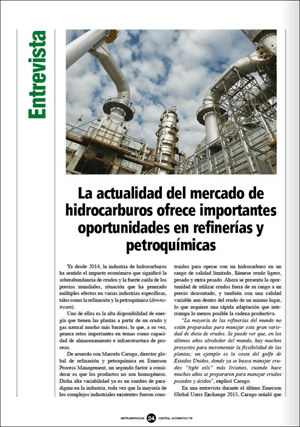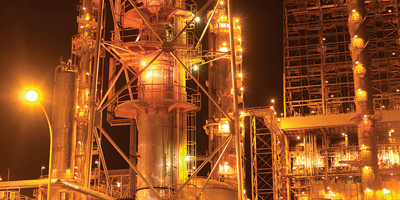 This article was first published in the Spanish language—La actualidad del mercado de hidrocarburos ofrece importantes oportunidades en refinerías y petroquímicas in Instrumentacion y Control magazine and is translated and posted with permission from the publisher.
This article was first published in the Spanish language—La actualidad del mercado de hidrocarburos ofrece importantes oportunidades en refinerías y petroquímicas in Instrumentacion y Control magazine and is translated and posted with permission from the publisher.
Since 2014, the hydrocarbon industry has felt what the economic impact overabundance of crudes and sharp drop in world prices has meant. This situation has caused various effects in several industries, such as refining and petrochemicals (downstream of oil & gas production).
One of the effects of high-energy availability is that plants have from much cheaper crude and natural gas supplies. This in turn creates important challenges on issues such as storage capacity and processing infrastructures.
According to Marcelo Carugo, Director, Global Refining and Petrochemical Industries, Emerson Process Management, a second factor to consider is that products are not homogeneous. This high variability is a new paradigm in the industry, given that the majority of existing industrial facilities were built to operate with a hydrocarbon in a range of limited quality, that is light, heavy or extra heavy oil. Now refiners have the opportunity to use crudes outside their typically used ranges at a discounted price. With a variable quality even within the oil from one location, this requires quick adaptation to minimize disruption as little as possible in the production process.“Most refineries in the world are not ready to handle this great variety of crudes. You can see that in recent years around the world, there are many projects to increase plant flexibility. An example is the gulf coast of the USA, where downstream producers are already seeking to handle lighter tight oils, when many years ago they were ready to handle acid and heavy crudes,” explained Carugo.
In an interview during the last Emerson Global Users Exchange 2015, Carugo mentioned that the current and future units should have the characteristics of incorporating technologies that will allow maximizing plant production when refining crude stocks of wide quality variability, such as shale oil, whose qualities vary even within the same location. These technologies are responsible for determining the crude quality minute-by-minute, allowing the modification of processing in the crude unit while monitoring the potential bottlenecks, such as accelerated fouling, tower flooding or capacity overload.
Within this context and taking into account the large-scale conversions in refineries, automation technology providers point to the development of devices based on Industrial Internet of Things (IIoT) to obtain efficiency and value in each of the plant activities.
According to Carugo, an example is the concept of Pervasive Sensing. It allows monitoring that–until a few years ago–were monitored with manual routines. And with crude compatibility problems or high variability, closely monitor assets with a higher frequency than is possible with manual rounds. For many assets, it is not viable to monitore them online due to the high cost of power and/or signal wiring.
This wireless approach improves operational experiences when collecting large quantities of information from operating smart devices, displays the aggregated information in an index of asset health, and allows action to be preemptively taken by using data to predict when a machine needs maintenance. These actions translate into reduce downtime by avoiding unplanned shutdowns or process slow downs.
“Today, with crude prices and refinery margins, it is especially critical to prevent interrupted operations. However, you should seize the moment when turnarounds and shutdowns are performed to improve plant reliability, availability or operation. This practice of incorporating projects and capital during shutdowns is a global trend in petrochemical plants and refineries, increasing the budget of shutdowns by 15% to 50% to perform steps to improve operational improvements without affecting the shutdown schedule,” said Carugo.
 The process to achieve this begins with a preliminary assessment of user operations and after various visits, analyzing exactly which processes have the greatest improvement needs. This process assures the successful implementation of technologies and installed programs and its integration in the plan of plant shutdowns, as well as a return on investment that can often range between two and four months.
The process to achieve this begins with a preliminary assessment of user operations and after various visits, analyzing exactly which processes have the greatest improvement needs. This process assures the successful implementation of technologies and installed programs and its integration in the plan of plant shutdowns, as well as a return on investment that can often range between two and four months.
These technologies besides improving operations can improve regulatory compliance that is increasingly demanding in terms of emissions, and this data is indispensable in regulatory reporting and the social responsibilities to the communities in which these plants operate.
This is how–through automation–not only gasoline, diesel and other fuels can be produced in cleaner more efficient way, but it is also possible to optimize complex processes, such as reformulated product blending, as per the latest regulations Euro 5 and 6, EPA Tier 3, etc. This optimization allows for highly complex blending, without giving away quality of products in terms of specifications. These giveaways can represent annual losses of about three million dollars for 200,000 bpd-sized refineries, according to Carugo.
Additionally, work in the energy field is key in the compliance of new environmental regulations. Strategies in energy usage reductions and optimal control, either in generation, distribution in production complexes and consumption in plants, help ensure that each process in the refining process uses the minimum quantity of energy required and emissions for optimal performance.
Today, most areas within these industrial complexes estimate energy consumption levels. Technologies such as Pervasive Sensing allow for consumption measurements and other variables in areas where they were not practical or economically feasible.
Knowing in detail how much energy each piece of equipment uses opens great benefits including reduced emissions (oxide and carbon dioxide, among other components). Carugo acknowledged that, by the nature of the sector, processes can never be completely clean, but that we can minimize its impact.
Finally, Carugo highlighted the opportunity to improve the downstream operational performance by more than 5% per year by implementing First Quartile strategies in the downstream sector. In this regard, top quartile performance can have a significant impact on the bottom line:
- Plants in the first quartile spend 3.5 times less in maintenance than the ones operating in the fourth quartile of the industry.
- Plants in the first quartile have 14 % more mechanical availability than plants in the fourth quartile.
- Plants in the first quartile have a very high percentage of predictive and preventive maintenance versus a high percentage of corrective maintenance of plants in the fourth quartile.
- Availability of discounted crudes is efficiently seized avoiding bottlenecks.
- Compliance of quality and stocks of finished products is optimized.
From Jim: You can connect and interact with other refining and petrochemical experts in the Refining group in the Emerson Exchange 365 community.





